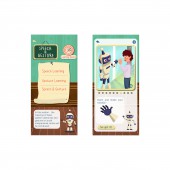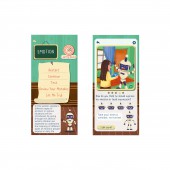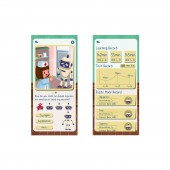DESIGN NAME:
Robot Partner
PRIMARY FUNCTION:
Autistic Children Training App
INSPIRATION:
Autism Spectrum Disorder (autism) is a pervasive developmental disorder characterized by severe, widespread social interactive problems and impairments in communicating skills. About 1 in 54 children has been identified with autism in the United States. The lack of professional therapists, especially in developing countries, and the high costs cause great difficulties for families with autistic children in getting enough and professional interventions. Therefore, developing an App that provides professional, convenient, and user-friendly training system for enhancing autistic children’s emotional and social skills will not only benefit families with autistic children, but also reduce the social and economic pressure.
UNIQUE PROPERTIES / PROJECT DESCRIPTION:
Robot Partner is a training mobile App aiming at improving the social and emotional skills for autistic children between 4 to- 6- year old. Previous studies have found that comparing to interacting with people in the real world, autistic children are more interested in communicating with robots (Dautenhahn and Werry, 2004). In addition, a growing number of studies have found that using a social robot to assist autistic children is a potentially useful area of research (David, Costescu, Matu, Szentagotai, and Dobrean, 2018; Wood, Zarakl, Robins, and Dautenhahn, 2019). Specifically, robot animation is effective in teaching children with autism to recognize and produce gestures in social communicating situation (So, Wong, Cabibihan, Lam, Chan, and Qian, 2016). In order to scaffold the development of autistic children with a scientific method and with an image they are interested in, a virtual character of robot was created to guide autistic children in taking part in training activities of Speech and Gesture, Emotion, and Social Communication in the present design.
OPERATION / FLOW / INTERACTION:
Robot Partner consists of modules of Speech and Gesture, Emotion, and Social Interaction to support the training based on common social dialogues and gestures, emotion expression, and comprehensive social communication between the robot partner and autistic children.
In the module of Speech& and Gesture, the meaning of basic speech utterances and gestures in social interpersonal context are introduced. From this module, children are expected to understand the basic communicating dialogs in the daily life.
In the module of Emotion, different types of human emotions in various situations are introduced. By going through this module, autistic children are expected to understand the meaning of different types of basic emotions and the ways to express their emotions.
The last module Social Interaction provides a variety of complex social scenes where autistic children are trained to react in proper speech utterances, facial expressions and gestures.
PROJECT DURATION AND LOCATION:
The project started in February 2019 and finished in July 2020 in Shenzhen.
|
PRODUCTION / REALIZATION TECHNOLOGY:
The App was designed mainly based on a systematical intervening program of autistic children’s social and emotional skills. The intervening program is developed based on research findings of a national research project from one of the designers in our team. In the neural imaging of the above projects, autistic children showed significant difference in the activation of dorsolateral prefrontal cortex when they were watching a robot interacting with them comparing to when they were interacting with a person. Such difference was not found in typical developing children. Dorsolateral prefrontal cortex plays a key role in the modulation of affective processing (Keuper Terrighena, Chan, Joughoefer, and Lee, 2018). Such findings indicated that autistic children are more sensitive to social interactions with robots comparing to with human, and this is revealed in the activation of cortex that related to affection. Therefore, trainings provided by a robot partner may elicit greater effects in enhancing autistic children’s social skills. Accordingly, we designed a virtual robot character as a partner and a trainer to help autistic children in several tasks. Specifically, a big number of studies have shown that, the core symptoms of ASD children are lacking of social interactive skills and communicating skills (American Psychiatric Association, 2013). They feel difficult to share the same feelings and interests with other people. In this sense, Robot Xiaozhao consists three modules of Speech and Gesture (So, Wong, Cabibihan, Lam, Chan, and Qian, 2016), Emotion and Social Interaction (Schertz, baker, Hurwitz, and Benner, 2011). The three modules support the training based on common social dialogues with gestures, emotional expression, and comprehensive social communication between the robot partner Xiaozhao and autistic children.
In addition, some other updated research findings regarding autistic children’s preference of color, sound and the looking of the robot were also adopted when designing the robot and the framework of the App. For example, an early study has suggested that autistic children prefer color options of blue, green, and brown (Grandgeorge and Masataka, 2016). Therefore, the above colors are selected as the main colors in the design of Robot Xiaozhao.
SPECIFICATIONS / TECHNICAL PROPERTIES:
Designed for iOS System
TAGS:
Interface Design, Autism Spectrum Disorder, Speech and Gesture, Emotion, Social Interaction
RESEARCH ABSTRACT:
The present App was designed based on two research projects from the designers. One is an intervening study supported by Humanities and Social Sciences Foundation of National Ministry of Education in China (Id: 17YJC190006), the other one is a neural imaging study supported by Shenzhen Natural Science Foundation. Specifically, in the brain imaging research project, we aimed at investigating the neural evidence regarding 45 autistic children’s atypical interests in interacting with robots comparing to interacting with people. This is the theoretical foundation of developing an image of robot in the training App. In the other intervention study, we developed a systematical computer-based training program to train autistic children’s social emotional skills in social interactive scenes. Autistic children went through three stages of training including Language and Gesture Recognition and Imitation, Emotion Recognition and Imitation, and Application Training. We also compared the social and emotional performance before and after the two months’ training. After the completion of the whole training system, the language and gestures skills of 30 autistic children were increased significantly. In addition, the score on Social Responsiveness Scale (Constantino and Gruber, 2005) increased, which reveals that the social and emotional behaviors and reactions of autistic children were improved after taking part in the intervention program. Taken together, the above two research projects and findings provide a scientific evidence indicating that a social and emotional training program with robot would be of great effectiveness on improving autistic children’s performance.
CHALLENGE:
Among the whole process of designing, there are two challenges and obstacles that we overcame. First, the target users of the product are special young children. Second, we need to guarantee the effects of the training system before it is applied into the App program. Therefore, on the one hand, the content of the training App needs to be professional and suitable to the above group of people. On the other hand, the whole intervening system which takes two months need to be implemented on at least thirty autistic children to make sure of the effectiveness. We have solved the above obstacles based on two research projects during the past three years. In our team, there is an expert in research regarding autistic children’s neural biological characteristics and the intervention. Since the year of 2017, the designer has already developed two research aiming at exploring the neural evidences on the atypical interests of autistic children in robot and on the intervening techniques of enhancing their social and emotional skills. By making use of the research findings, we are much confident that comparing to a human helper, the autistic children are more interested in the robot image we designed, and that would lead to better training outcomes.
ADDED DATE:
2020-07-14 08:21:28
TEAM MEMBERS (3) :
Shumeng Hou, Huicong Hu and Chengbo Zhao
IMAGE CREDITS:
Images by Shumeng Hou, Huicong Hu, 2020
|










